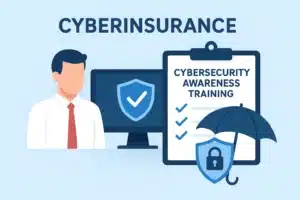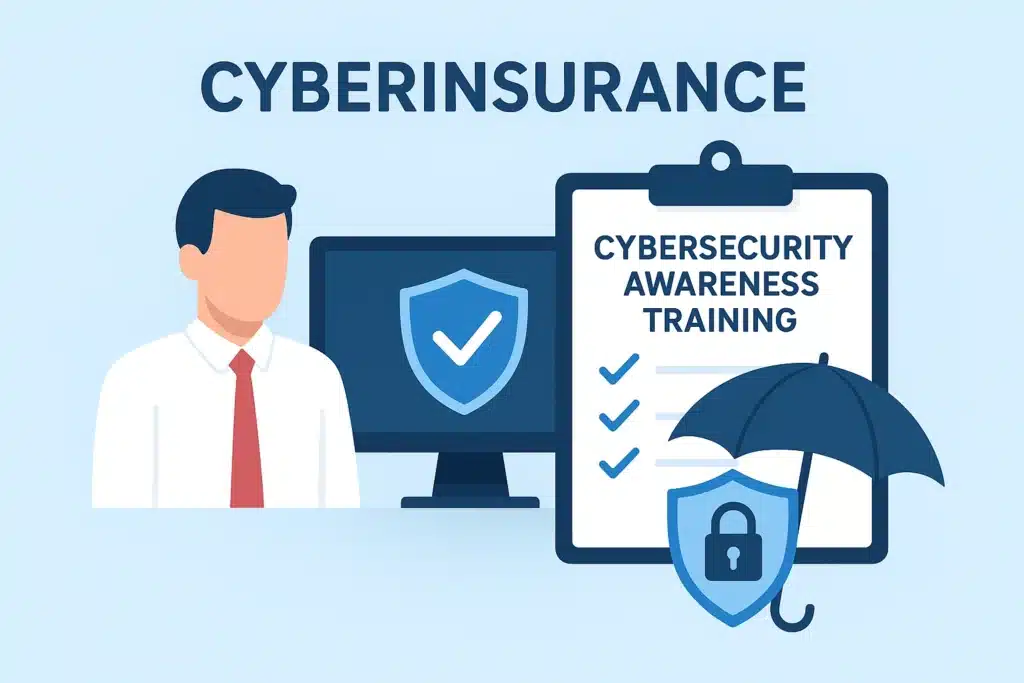In today’s corporate landscape, cyber risk is a boardroom issue. With sophisticated threats like ransomware, supply chain attacks, and phishing campaigns targeting businesses daily, executive leaders are under increasing pressure to protect digital assets, ensure compliance, and maintain business continuity. That’s where cyber insurance and cybersecurity awareness training come in—not as isolated measures, but as a powerful, complementary strategy.
Cyber Insurance: Mitigating the Inevitable
Cyber insurance is no longer a “nice to have”—it’s essential business infrastructure. A comprehensive policy can cover direct losses (e.g., data restoration, legal fees, breach notifications) and indirect consequences (e.g., regulatory fines, reputational damage, and business interruption).
But here’s the key: cyber insurance can help manage the fallout from an attack, but it can’t stop the attack itself. To truly mitigate risk, organizations must also reduce the likelihood of an incident occurring in the first place.
Why Security Awareness Training is Critical
Despite significant investments in advanced security tools, human error continues to be the leading cause of cyber incidents. In fact, according to Chubb’s Q2 Threat Intelligence Report, external remote services, phishing, and social engineering remain the primary attack vectors, collectively responsible for nearly 40% of incidents. Phishing emails, credential reuse, and accidental data exposure continue to create vulnerabilities that technology alone cannot fully address. Comprehensive training programs can play a pivotal role in mitigating these risks by empowering individuals to recognize, respond to, and prevent potential threats.
Security awareness training transforms all employees—from interns to executives—into a human firewall. A strong program educates staff on:
ü Identifying phishing and social engineering attempts
ü Using strong passwords and enabling MFA
ü Following data handling and privacy best practices
ü Recognizing insider threats and reporting anomalies
When regularly reinforced, this training helps build a security-conscious culture in which everyone plays a role in protecting the enterprise.
A Dual Defense Strategy
Cyber insurance and employee training address two sides of the cyber risk equation: response and prevention. Together, they provide a more resilient framework than either of them could on their own.
Benefits of a Combined Approach:
- Reduced Risk Exposure
Trained employees are less likely to trigger breaches, helping to lower incident frequency and severity—both key drivers of insurance claims. - Improved Insurance Outcomes
Insurers increasingly assess cyber maturity when underwriting policies. Demonstrating a robust training program can lead to more favorable premiums and terms. - Faster, Smarter Incident Response
Training ensures employees know how to report issues quickly. Early detection often means lower costs and shorter downtime—directly impacting the value of your policy. - Regulatory Compliance & Legal Safeguards
Many data protection laws (like GDPR or HIPAA) emphasize employee training. Coupling that with cyber insurance helps meet compliance standards and demonstrates due diligence in court, if needed. - Enhanced Corporate Reputation
Preventing a breach is always better than dealing with the aftermath of one. Clients, partners, and shareholders all take note when security is treated as a strategic priority.
Final Thoughts
In a digital-first economy, cyber resilience must be both reactive and proactive. Cyber insurance helps soften the blow of an incident, while cybersecurity training empowers your workforce to prevent one.
Forward-thinking companies treat both as core components of their cyber risk strategy—not just nice-to-haves for IT, but business imperatives. If your organization is serious about protecting its assets, reputation, and bottom line, investing in both is the smartest move you can make.
– The GLS Team
Training People. Transforming Behavior. Reducing Human Risk.

Cyber Insurance & Awareness Training: A Smart Business Match
Cyber threats are rising—pair cyber insurance with awareness training for stronger protection, compliance, and business resilience.

Travel Smart, Stay Secure: Cybersecurity Tips for Employees on the Go
Whether you’re heading to a client meeting across the country or escaping for a long awaited beach vacation, travel season is in full swing. But while you’re packing chargers and checking flight times, it’s easy to forget that cybercriminals are also planning…and they’re targeting travelers.

Fighting Fire with Fire: How Phishing Simulation Must Evolve
Phishing attacks have grown far more advanced, leveraging AI and social engineering to craft convincing scams that traditional training can’t keep up with. To effectively prepare employees, phishing simulations must evolve—moving away from outdated templates toward sophisticated, personalized, and AI-powered training that mirrors real-world threats. Organizations should tailor simulations to user roles and risk levels, and adopt automation or Simulation-as-a-Service models to ensure training is timely, scalable, and relevant. The future of phishing defense depends on smarter, continuous simulation that keeps pace with the evolving threat landscape.

Deepfakes: The Rising Threat Blurring Lines Between Truth and Deception
As AI-generated deepfakes become more realistic and accessible, cybercriminals are weaponizing this technology to manipulate, deceive, and defraud. From impersonating executives in phishing schemes to spreading disinformation through synthetic media, the rise of deepfakes presents a new frontier in cybersecurity threats. This blog explores how deepfakes work, why they pose a serious risk, and what your organization can do to stay ahead of this evolving digital deception.

AI Clone Wars: Revenge of the 5th!
We often talk about phishing emails and malware, but there’s a newer, subtler threat emerging—AI voice cloning. Attackers are now harvesting voice samples from publicly accessible sources (videos, calls, webinars) and using artificial intelligence to create convincing deepfake audio. Why? Because nothing builds trust quicker than hearing a familiar voice.

Cyber Hygiene for Remote Workers: Best Practices to Stay Secure Online
Remote work has become the new norm, offering flexibility and convenience—but it also comes with increased cybersecurity risks. Without the protection of corporate networks, remote workers are prime targets for cybercriminals.



